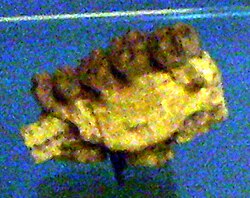Samburupithecus: Difference between revisions
m Tagging and general fixes, added orphan tag |
m link with new article on Dutch wikipedia |
||
| Line 38: | Line 38: | ||
[[fr:Samburupithecus]] |
[[fr:Samburupithecus]] |
||
[[nl: Samburupithecus]] |
|||
Revision as of 16:31, 14 November 2008
| Samburupithecus Temporal range: late Miocene
| |
|---|---|

| |
| Samburupithecus kiptalami fossil, Muséum national d'histoire naturelle, Paris | |
| Scientific classification | |
| Kingdom: | |
| Phylum: | |
| Class: | |
| Order: | |
| Superfamily: | |
| Family: | |
| Subfamily: | |
| Genus: | †Samburupithecus
|
| Species: | †S. kiptalami
|
| Binomial name | |
| †Samburupithecus kiptalami | |
Samburupithecus was a primate that lived in Kenya during the middle to late Miocene. The one species in this genus, Samburupithecus kiptalami, is known only from a maxilla fragment dated to 9.5 Ma discovered by Hidemi Ishida and Martin Pickford in 1997. Samburupithecus was approximately 60 kg and was most likely a frugivorus terrestrial quadruped (Fleagle, 1999). Paleoenvironmental reconstructions indicate that Samburupithecus most likely lived in a wooded habitat surrounded by savannah (Tsujikawa, 2005).
Defining cranial traits of this genus include low, broad zygomatics, straight alveolar process and large maxillary sinus. Defining dental traits include three-rooted premolars, thick enamel and buonodont cusps (Ward, 2002). Unlike many other Miocene hominoids, Samburupithecus has teeth that are elongated from front to back. This feature links the taxon to gorillas, chimpanzees and hominins, but its relationships within this clade are presently unknown (Fleagle, 1999).
See also
- List of fossil sites (with link directory)
- List of hominina (hominid) fossils (with images)
References
- Fleagle, J.F. (1999) Primate Adaptation and Evolution. Elsevier Academic Press. ISBN 978-0122603419
- Tsujikawa, Hiroshi. "Palaeoenvironment of Samburupithecus Based on its Associated Fauna" African Study Monographs, Suppl., 32: 51-62 http://jambo.africa.kyoto-u.ac.jp/kiroku/asm_suppl/abstracts/pdf/ASM_s32/51-62.pdf
- Ward, S.C. and Duren, D.L. (2002). The Primate Fossil Record. Cambridge University Press. ISBN 978-0521663151
- Mikko's Phylogeny archives
